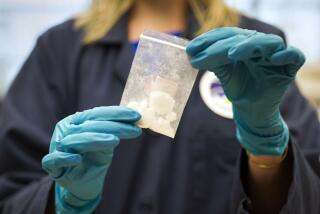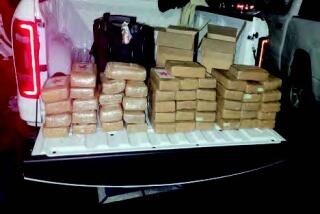Heroin Shipments Through China to Western Markets Post Sharp Rise
- Share via
KUNMING, China — In the hilly jungles and bustling market towns along China’s southern border, peasants and traders cross the frontier from Burma each day weighed down by powdered gold--heroin bound for the other side of the world.
Like the honest traders who sell jade, vegetables and other goods, the smugglers cross with border passes issued by Burmese rebel groups, the only authority in the region along the twisting, porous frontier with China’s Yunnan province.
But the rebels also are the most notorious drug merchants of the infamous Golden Triangle region where the borders of Burma, Laos and Thailand meet to the south of Yunnan--an irony that makes the Yunnan border the opening to the Chinese heroin trail.
The route begins in the opium poppy fields and heroin refineries of the Golden Triangle and ends on the streets of cities in the United States, Canada and Europe.
From Kunming, the Yunnan province capital, Chinese officials are presiding over a so-far losing battle to halt a booming trade in high-grade heroin through south China to Hong Kong and the West.
The smuggling also has made Yunnan the source that is recreating the nightmare of drug addiction in China.
Before the 1949 Communist revolution, after which China largely eliminated drugs, Yunnan was home to many of the country’s 20 million opium addicts.
Now, with China having reawakened to drugs only in the last five years, Yunnan has several thousand addicts and, by dint of shared needles, the country’s only significant AIDS problem. Heroin traced to Yunnan also has appeared in half a dozen other provinces.
“The problem is serious,” acknowledges Chen Chenyi, deputy director of the provincial anti-drug police. “We are determined not to allow the drugs of old China to spread in new China.”
Despite the government’s determination, the lure of drug money looms large in a region of ethnic minorities who are among China’s poorest people, with incomes averaging $100 a year.
A border smuggler can earn $4,000 for a kilo of 90% pure No. 4 heroin. Its street value in Kunming swells to $20,000. By the time it reaches Los Angeles addicts, diluted to under 10% purity, the same kilo fetches $1.5 million.
The temptation of money outweighs the dangers of a harsh legal system unfettered by constraints on police tactics. Yunnan province alone executed 60 people last year on drug offenses.
But the purer heroin now refined in the laboratories of Burma means smaller shipments and easier concealment. And demand in the United States has increased with the flood of crack cocaine, as addicts use heroin to come down from the crack high.
“It’s the drug of the ‘90s,” said a Western diplomat in Beijing who follows the drug trade. “And it’s a demand-pull market.”
The Golden Triangle supplies half the heroin consumed in the United States and, as Thailand and other Southeast Asian nations have become tougher, smugglers have turned to the China trail.
Police seizures of heroin in Yunnan last year nearly doubled that of 1988, to 646 pounds--half the nationwide total. Western diplomats estimate that far more seeps through.
The government has responded with a national effort to stem the flow, but its desire clearly exceeds its resources.
Beijing has extolled a recently established 1,300-member anti-drug task force in Yunnan. But Chen concedes that the numbers include only reassigned officials and rehired retirees.
Chen also makes a startling declaration: Not one police officer or soldier in border regions has been prosecuted for drug-related corruption. He cites “the advantage of our socialist system.”
Yet foreigners and Chinese who have visited the smuggling zones say despite frequent checkpoints and searches, police often appear at best uninterested in shipments destined for the West.
“They only pay attention when someone is selling it in China,” said a young Chinese, close to the drug trade, who was sitting in a local bar as small heroin deals were negotiated at a nearby table.
According to officials, trafficking sources and diplomats in Kunming and Beijing, the new heroin trail is a multitentacled route often run by ethnic Chinese working with Hong Kong gangs.
Some heroin is simply carried across the unguarded frontier. But much is smuggled through the border towns of Ruili, 300 miles west of Kunming.
A favorite method is lumber shipments, where smugglers strip tree bark, hide heroin inside and reseal it. Other smugglers carry it in luggage and goods for sale.
From the border, the shipments go to transit towns in western Yunnan or to Kunming, then overland to adjacent Guizhou and Guangxi provinces to freewheeling Guangdong (Canton) province.
Authorities often cite the large number of trucks that enter Hong Kong each day overland from Guangdong, but trafficking sources say most of the heroin goes aboard fishing boats or cargo ships from southern China to one of Hong Kong’s dozens of outlying islands.
Heroin also has turned up in a shipment of umbrellas from Canton to New York and in cans of litchi fruit shipped from China to Los Angeles. Authorities recently found the first shipment of China-produced “ice”--synthetic amphetamine--bound for the West.
Chinese officials cite the impossibility of policing Yunnan province’s 2,500-mile border with Burma, Laos and Vietnam. They insist that there is little opium growing or refining on their side and point to Burma.
“The drug problem will not be solved unless the sources and processing places are eliminated,” said Yuong Guangjin, a senior official of the Yunnan health department.
One means of improving interdiction--international cooperation--has been plagued by problems. Chinese officials, for example, can have no formal contact with the Burmese rebel groups.
The U.S. Drug Enforcement Administration began last year to work with Chinese police on such tactics as using sniffer dogs and tracing so-called “precursor chemicals” used to refine opium. But one major such item is kerosene--widely used in rural areas.
Yet U.S.-China cooperation has been placed in doubt by last year’s Chinese crackdown on the pro-democracy movement and by what should have been the two nations’ first major joint drug case.
In 1988, Chinese and U.S. agents cracked a ring smuggling heroin to San Francisco in the bellies of goldfish. But this year, at a trial in San Francisco, a Chinese suspect testifying in the case unexpectedly asked U.S. officials for political asylum.
A mistrial was declared and the Chinese were outraged. A decision on the suspect’s request is pending.
But the DEA has its own needs from China--for intelligence on traffickers and for Chinese police to learn how to make controlled drug buys, so agents can work up the chain past arresting the small-time dealers to the entire network.
“There’s sensitivity about helping the Chinese police now,” said a U.S. official in Beijing. “But drugs are a serious problem in the States and the feeling generally is that regardless of the political differences, we’re going to cooperate.”
More to Read
Sign up for Essential California
The most important California stories and recommendations in your inbox every morning.
You may occasionally receive promotional content from the Los Angeles Times.










